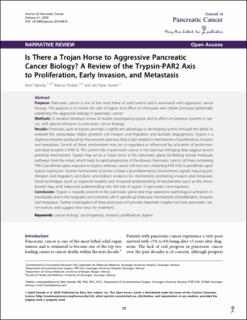| dc.contributor.author | Søreide, Kjetil | |
| dc.contributor.author | Roalsø, Marcus Thomas Thor | |
| dc.contributor.author | Aunan, Jan Rune | |
| dc.date.accessioned | 2021-02-22T10:41:48Z | |
| dc.date.available | 2021-02-22T10:41:48Z | |
| dc.date.created | 2020-09-23T11:21:31Z | |
| dc.date.issued | 2020-02 | |
| dc.identifier.citation | Søreide, K., Roalsø, M., Aunan, J.R. (2020) Is There a Trojan Horse to Aggressive Pancreatic Cancer Biology? A Review of the Trypsin-PAR2 Axis to Proliferation, Early Invasion, and Metastasis. Journal of Pancreatic Cancer, 6 (1), 12-20. | en_US |
| dc.identifier.issn | 2475-3246 | |
| dc.identifier.uri | https://hdl.handle.net/11250/2729467 | |
| dc.description.abstract | Purpose: Pancreatic cancer is one of the most lethal of solid tumors and is associated with aggressive cancer biology. The purpose is to review the role of trypsin and effect on molecular and cellular processes potentially explaining the aggressive biology in pancreatic cancer.
Methods: A narrative literature review of studies investigating trypsin and its effect on protease systems in cancer, with special reference to pancreatic cancer biology.
Results: Proteases, such as trypsin, provides a significant advantage to developing tumors through the ability to remodel the extracellular matrix, promote cell invasion and migration, and facilitate angiogenesis. Trypsin is a digestive enzyme produced by the exocrine pancreas that is also related to mechanisms of proliferation, invasion and metastasis. Several of these mechanisms may be co-regulated or influenced by activation of proteinase-activated receptor 2 (PAR-2). The current role in pancreatic cancer is not clear but emerging data suggest several potential mechanisms. Trypsin may act as a Trojan horse in the pancreatic gland, facilitating several molecular pathways from the onset, which leads to rapid progression of the disease. Pancreatic cancer cell lines containing PAR-2 proliferate upon exposure to trypsin, whereas cancer cell lines not containing PAR-2 fail to proliferate upon trypsin expression. Several mechanisms of action include a proinflammatory environment, signals inducing proliferation and migration, and direct and indirect evidence for mechanisms promoting invasion and metastasis. Novel techniques (such as organoid models) and increased understanding of mechanisms (such as the microbiome) may yield improved understanding into the role of trypsin in pancreatic carcinogenesis.
Conclusion: Trypsin is naturally present in the pancreatic gland and may experience pathological activation intracellularly and in the neoplastic environment, which speeds up molecular mechanisms of proliferation, invasion, and metastasis. Further investigation of these processes will provide important insights into how pancreatic cancer evolves, and suggest new ways for treatment. | en_US |
| dc.language.iso | eng | en_US |
| dc.publisher | Mary Ann Liebert, Inc. | en_US |
| dc.rights | Navngivelse 4.0 Internasjonal | * |
| dc.rights.uri | http://creativecommons.org/licenses/by/4.0/deed.no | * |
| dc.subject | bukspyttkjertelkreft | en_US |
| dc.subject | kreft | en_US |
| dc.subject | onkologi | en_US |
| dc.subject | pancreatic cancer | en_US |
| dc.subject | kreft i bukspyttkjertelen | en_US |
| dc.title | Is There a Trojan Horse to Aggressive Pancreatic Cancer Biology? A Review of the Trypsin-PAR2 Axis to Proliferation, Early Invasion, and Metastasis | en_US |
| dc.type | Peer reviewed | en_US |
| dc.type | Journal article | en_US |
| dc.description.version | publishedVersion | en_US |
| dc.rights.holder | © Kjetil Søreide et al. 2020. | en_US |
| dc.subject.nsi | VDP::Medisinske Fag: 700::Klinisk medisinske fag: 750::Onkologi: 762 | en_US |
| dc.source.pagenumber | 12-20 | en_US |
| dc.source.volume | 6 | en_US |
| dc.source.journal | Journal of Pancreatic Cancer | en_US |
| dc.source.issue | 1 | en_US |
| dc.identifier.doi | 10.1089/pancan.2019.0014 | |
| dc.identifier.cristin | 1832433 | |
| cristin.ispublished | true | |
| cristin.fulltext | original | |
| cristin.qualitycode | 1 | |

